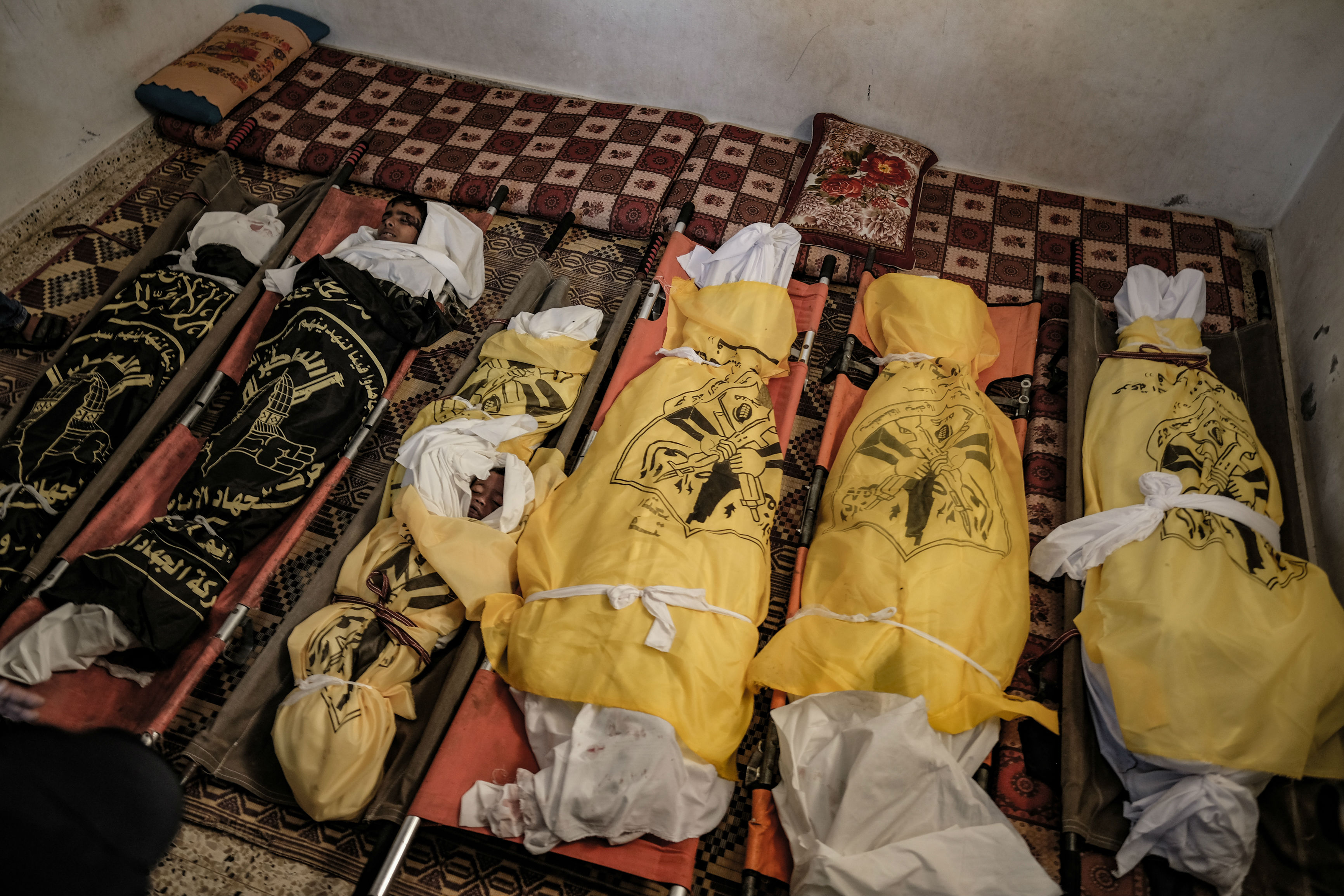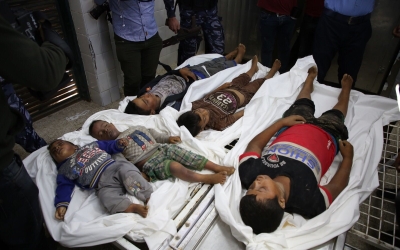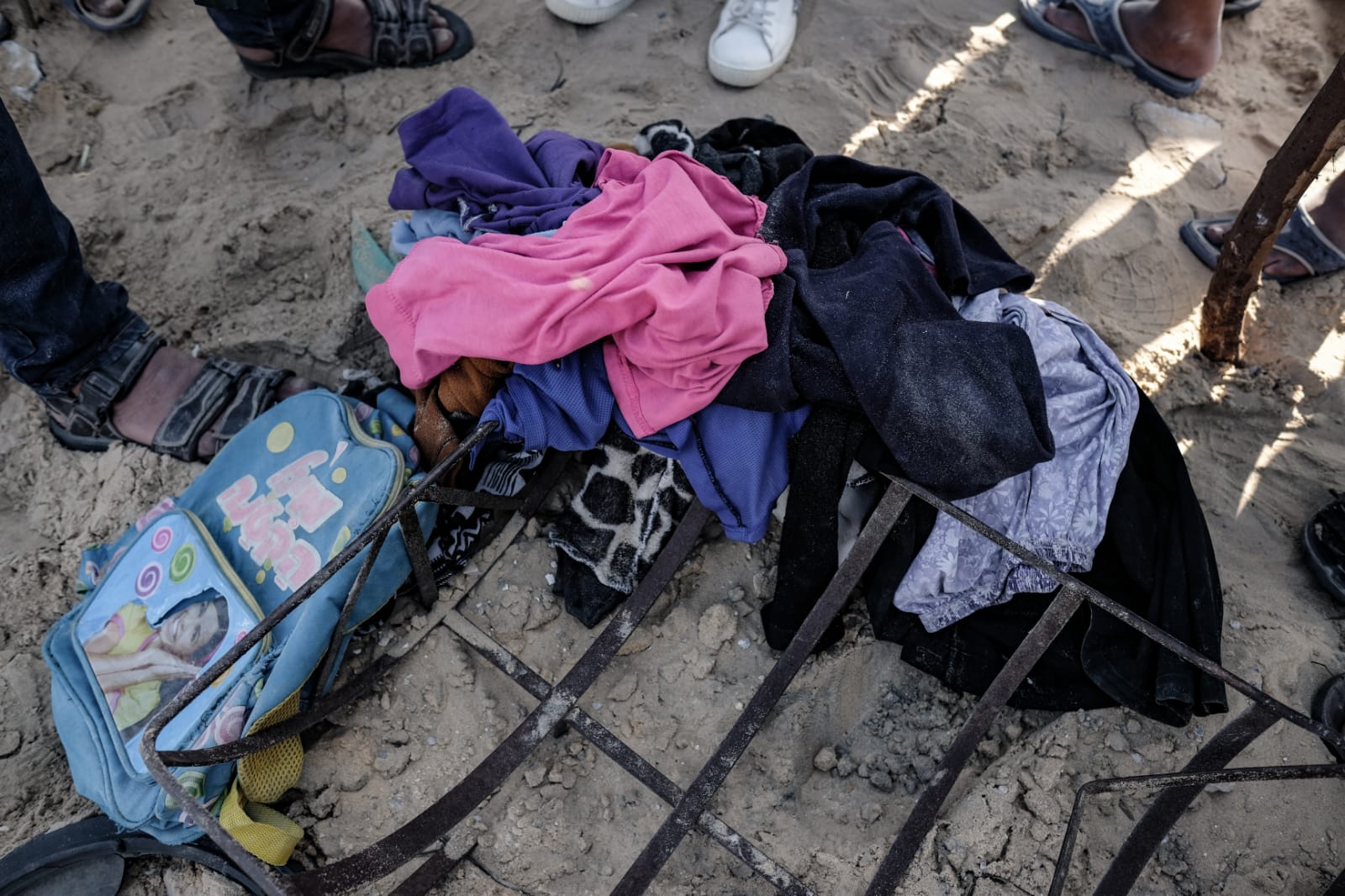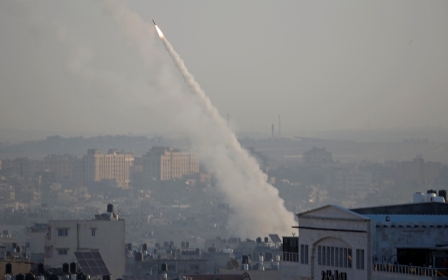‘All that’s left are their school uniforms’: Israeli air strike kills eight Palestinian relatives

A large hole now stands where, only one day earlier, two homes were torn to the ground by Israeli air strikes. Looking over the debris, dozens of relatives and neighbours gathered to remember the eight members of the al-Sawarka family, who were killed in the attack.
The two adjacent shabby houses with tin ceilings were located in a marginalised area of the Deir al-Balah refugee camp on the southern Gaza Strip.
The Sawarka family members were in bed when the attack took place after midnight on Wednesday, turning their homes into rubble.
The Gaza Strip witnessed an onslaught for two consecutive days, following Israel’s assassination of senior Islamic Jihad commander Bahaa Abu al-Atta and his wife on Tuesday.
The Palestinian armed group retaliated by launching a barrage of rockets into Israel for two days, before the two parties agreed on a ceasefire on Thursday following joint Egyptian and UN mediation.
New MEE newsletter: Jerusalem Dispatch
Sign up to get the latest insights and analysis on Israel-Palestine, alongside Turkey Unpacked and other MEE newsletters
The relatives who died in the attack have been identified by the Gaza Ministry of Health as Rasmi al-Sawarka, 45; Yusra al-Sawarka, 43; Mariam al-Sawarka, 45; Waseem al-Sawarka, 13; Muhannad al-Sawarka, 12; Moaz al-Sawarka, 7; and at least two other children whose names and ages were not specified.
‘Everything was red’
“I was sleeping when the house was bombarded,” 11-year-old Diyaa Rasmi al-Sawarka, told Middle East Eye. “I woke up terrified and everything around me was red, I could not see anything.”
“I tried to run away but my foot was stuck under the rubble. I started screaming but no one heard me, all my family members were under the rubble. I was trying to pull my foot [out] when I found my little brother struggling to get out from under the rubble. I helped him out, then pulled out my foot and rushed behind him,” the young boy recalled.
Diyaa, who sustained minor injuries to the leg and head, was then transferred to the hospital, where he found out that he had lost his father and a number of his cousins.
As a result of the attack, eight relatives, including five children and two women, were killed, and 12 others were injured.
Among the crowd surrounding the remains of the house stood friends of 12-year-old Muhannad al-Sawarka, who was killed in the attack.
“We heard the massive explosion at midnight and immediately rushed to their house,” said Mohammed Mehsen, 14. “I was shocked. Muhannad’s house completely disappeared, as if it had never been there.”
Although Muhannad was two years younger than Mohammed, he was his “closest friend”.
“I knew Muhannad since we were in kindergarten, we were friends and neighbours, and used to go to school together,” the boy said.
“Muhannad and I used to play with our bicycles every day after school, but when it got dark at night, we loved to play hide and seek,” he smiled. “He loved animals and especially dogs, he always wanted to adopt one”
Following the attack, the Israeli army's Arabic media spokesman Avichay Adraee justified the overnight strike in a tweet, claiming that Diyaa’s father Rasmi al-Sawarka, 45, who was killed in the attack, was “a leader at the Islamic Jihad and of the rocket unit in the central brigade of the organisation”.
But for Ramy Abdu, chairman of the Euro-Mediterranean Human Rights Monitor, “even if Israel explains the attack by claiming it hit a member of the Islamic Jihad, this does not and can never be an excuse for targeting two homes containing dozens of civilians, including children and women”.
“The mass killing of a whole family reflects Israeli disregard for the lives of innocent civilians and children, which was translated in practice during its repeated attacks on Gaza,” he added.
Abdu said Israel’s attacks on the besieged Gaza Strip this week could amount to war crimes under international law.
“This constitutes a flagrant violation of the principles of distinction and proportionality, which prohibit direct attacks on civilian populations or on civilian objects, and obliges all parties to adopt precautionary measures,” he stated.
According to a relative of the Sawarka family, Taleb Mesmeh, 46, there were around 22 persons in the two homes when they were targeted.
“When we heard the explosions, we thought they were just air raids on empty agricultural land or military sites,” he told MEE. “We never expected that all these missiles targeted a civilian home that looked like any normal house.”
According to Mesmeh, although the two homes were made of wood and tin, they were hit by at least three missiles.
“I saw the neighbours and the Civil Defence retrieving their bodies from the rubble. They were torn into pieces and there was blood everywhere,” he continued.
‘All what’s left are their school uniforms’
As he collected children’s clothes from the rubble, shaking the dust off the small school uniforms, Mesmeh screamed: “This is Israel, targeting children inside their homes.”
“Look at this, all that’s left are their school uniforms,” he said. “This is Mariam’s school uniform, she was still in first grade. What did she do to be killed?”
The Gaza Ministry of Health has yet to confirm that a younger Mariam Sawarka was among those killed in the attack.
Rasmi Sawarka’s 15-year-old daughter, stood in shock, barely able to speak as she processed the loss of her family.
“He had always encouraged me to go to school and pursue my education,” was all she could say about her father.
Rasmi’s sister Umm Moataz, 35, said that the last time she saw her brother was on Tuesday, when the family gathered for lunch.
“I found out about the attack about an hour later. Someone called my husband and he got nervous. He did not tell me anything, but his attempts to conceal the news made me suspicious,” she told MEE.
“I cannot explain what happened, there is no reason for all these children and civilians to be targeted,” she told MEE. “All that I can say is that we have always witnessed Israel’s attitude of acting above the law.”
Middle East Eye delivers independent and unrivalled coverage and analysis of the Middle East, North Africa and beyond. To learn more about republishing this content and the associated fees, please fill out this form. More about MEE can be found here.








